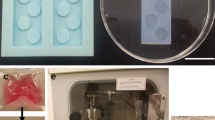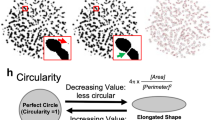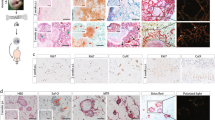Abstract
High density micromass culture of limb bud mesenchymal stem cells isolated from mouse embryos represents a well-established model to study chondro- and osteogenesis. In spite of wide usage of the limb bud model, the mechanisms underlying cartilage nodule growth remain unclear. To determine whether cartilage nodules grow solely by induction of surrounding cells or proliferation of cells within the nodules, we performed BrdU/Collagen II (Col II) double-labelling and 3D reconstruction of growing cartilage nodules. We demonstrated that Col II-positive replicating chondrocytes are present throughout the nodules with the majority of replicating cells localized on the top (cell-medium interface) and periphery/sides of nodules. Kinetic analysis of cellular proliferation within the nodules demonstrated the time-dependent reduction in number of Col II-positive replicating cells. The sequential expression of Col I, Col II, Col X, parathyroid hormone related peptide receptor 1 (Pthr1), bone sialoprotein (Bsp) and osteocalcin (Ocn) mRNAs was similar to that characterizing chondrocyte differentiation and maturation in vivo. We conclude that the limb bud model recapitulates events seen during endochondral bone formation: cellular aggregation, proliferation, differentiation and maturation to hypertrophy. We also conclude that not only induction of peri-nodular mesenchymal cells but also proliferation of chondrocytes within cartilage nodules contribute to cartilage nodule growth.







Similar content being viewed by others
Abbreviations
- ALP:
-
Alkaline phosphatase
- BrdU:
-
Bromodeoxyuridine
- BSP:
-
Bone sialoprotein
- Col:
-
Collagen
- FITC:
-
Fluorescein isothiocyanate
- OCN:
-
Osteocalcin
- PBS:
-
Phosphate buffered saline
- PI:
-
Propidium iodide
- PSA:
-
Puck’s saline without glucose
- PSG:
-
Puck’s saline with glucose
- PTHR1:
-
Parathyroid hormone related peptide receptor 1
- SEM:
-
Standard error of the mean
References
DeLise, A. M., Stringa, E., Woodward, W. A., Mello, M. A., & Tuan, R. S. (2000). Embryonic limb mesenchyme micromass culture as an in vitro model for chondrogenesis and cartilage maturation. Methods in Molecular Biology, 137, 359–375.
Lengner, C. J., Lepper, C., van Wijnen, A. J., Stein, J. L., Stein, G. S., & Lian, J. B. (2004). Primary mouse embryonic fibroblasts: a model of mesenchymal cartilage formation. Journal of Cellular Physiology, 200, 327–333.
O’Driscoll, S. W., Recklies, A. D., & Poole, A. R. (1994). Chondrogenesis in periosteal explants. An organ culture model for in vitro study. J Bone Joint Surg. Am., 76, 1042–1051.
Gillotte, D. M., Fox, P. L., Mjaatvedt, C. H., Hoffman, S., & Capehart, A. A. (2003). An in vitro method for analysis of chondrogenesis in limb mesenchyme from individual transgenic (hdf) embryos. Methods in Cell Science, 25, 97–104.
Dienstman, S. R., Biehl, J., Holtzer, S., & Holtzer, H. (1974). Myogenic and chondrogenic lineages in developing limb buds grown in vitro. Developmental Biology, 39, 83–95.
Aydelotte, M. B., & Kochhar, D. M. (1972). Development of mouse limb buds in organ culture: chondrogenesis in the presence of a proline analog, L-azetidine-2-carboxylic acid. Developmental Biology, 28, 191–201.
Weston, A. D., Rosen, V., Chahndraratna, R. A. S., & Underhill, T. M. (2000). Regulation of skeletal progenitor differentiation by the BMP and retinoid signaling pathways. The Journal of Cell Biology, 148286, 679–690.
Boskey, A. L., Paschalis, E. P., Binderman, I., & Doty, S. B. (2002). BMP-6 accelerates both chondrogenesis and mineral maturation in differentiating chick limb-bud mesenchymal cell cultures. Journal of Cellular Biochemistry, 84, 509–519.
DeLise, A. M., & Tuan, R. S. (2002). Alterations in the spatiotemporal expression pattern and function of N-cadherin inhibit cellular condensation and chondrogenesis of limb mesenchymal cells in vitro. Journal of Cellular Biochemistry, 87, 342–359.
DeLise, A. M., & Tuan, R. S. (2002). Analysis of N-cadherin function in limb mesenchymal chondrogenesis in vitro. Developmental Dynamics, 225, 195–204.
Stanton, L. A., Sabari, S., Sampaio, A. V., Underhill, T. M., & Beier, F. (2004). p38 MAP kinase signalling is required for hypertrophic chondrocyte differentiation. Biochemical Journal, 378, 53–62.
Ahrens, P. B., Solursh, M., & Reiter, R. S. (1977). Stage-related capacity for limb chondrogenesis in cell culture. Developmental Biology, 60, 69–82.
Pizette, S., & Niswander, L. (2000). BMPs are required at two steps of limb chondrogenesis: formation of prechondrogenic condensations and their differentiation into chondrocytes. Developmental Biology, 219, 237–249.
Hatakeyama, Y., Tuan, R. S., & Shum, L. (2004). Distinct functions of BMP4 and GDF5 in the regulation of chondrogenesis. Journal of Cellular Biochemistry, 91, 1204–1217.
Williams, D. R., Jr., Presar, A. R., Richmond, A. T., Mjaatvedt, C. H., Hoffman, S., & Capehart, A. A. (2005). Limb chondrogenesis is compromised in the versican deficient hdf mouse. Biochemical and Biophysical Research Communications, 334, 960–966.
Owens, E. M., & Solursh, M. (1981). In vitro histogenic capacities of limb mesenchyme from various stage mouse embryos. Developmental Biology, 88, 297–311.
Mello, M. A., & Tuan, R. S. (1999). High density micromass cultures of embryonic limb bud mesenchymal cells: an in vitro model of endochondral skeletal development. In Vitro Cellular & Developmental Biology. Animal, 35, 262–269.
Zakany, R., Bako, E., Felszeghy, S., Hollo, K., Balazs, M., Bardos, H., et al. (2001). Okadaic acid-induced inhibition of protein phosphatase 2A enhances chondrogenesis in chicken limb bud micromass cell cultures. Anat. Embryol. (Berl), 203, 23–34.
Wroblewski, J., Engstrom, M., Edwall-Arvidsson, C., Sjoberg, G., Sejersen, T., & Lendahl, U. (1996). Nestin distribution in the developing limb bud in vivo and in vitro. Annals of the New York Academy of Sciences, 785, 353–355.
Stanton, L. A., Underhill, T. M., & Beier, F. (2003). MAP kinases in chondrocyte differentiation. Developmental Biology, 263, 165–175.
Grigoriadis, A. E., Heersche, J. N., & Aubin, J. E. (1996). Analysis of chondroprogenitor frequency and cartilage differentiation in a novel family of clonal chondrogenic rat cell lines. Differentiation, 60, 299–307.
Bonnelye, E., Merdad, L., Kung, V., & Aubin, J. E. (2001). The orphan nuclear estrogen receptor-related receptor alpha (ERRalpha) is expressed throughout osteoblast differentiation and regulates bone formation in vitro. The Journal of Cell Biology, 153, 971–984.
Boskey, A. L., Stiner, D., Doty, S. B., Binderman, I., & Leboy, P. (1992). Studies of mineralization in tissue culture: optimal conditions for cartilage calcification. Bone and Mineral, 16, 11–36.
San Antonio, J. D., & Tuan, R. S. (1986). Chondrogenesis of limb bud mesenchyme in vitro: stimulation by cations. Developmental Biology, 115, 313–324.
Hoffman, L. M., Garcha, K., Karamboulas, K., Cowan, M. F., Drysdale, L. M., Horton, W. A., et al. (2006). BMP action in skeletogenesis involves attenuation of retinoid signaling. The Journal of Cell Biology, 174, 101–113.
Ahrens, P. B., Solursh, M., Reiter, R. S., & Singley, C. T. (1979). Position-related capacity for differentiation of limb mesenchyme in cell culture. Developmental Biology, 69, 436–450.
Jiang, H., Soprano, D. R., Li, S. W., Soprano, K. J., Penner, J. D., Gyda, M., III, et al. (1995). Modulation of limb bud chondrogenesis by retinoic acid and retinoic acid receptors. International Journal of Developmental Biology, 39, 617–627.
Edwall-Arvidsson, C., & Wroblewski, J. (1996). Characterization of chondrogenesis in cells isolated from limb buds in mouse. Anat. Embryol. (Berl), 193, 453–461.
Mello, M. A., & Tuan, R. S. (2006). Effects of TGF-beta1 and triiodothyronine on cartilage maturation: in vitro analysis using long-term high-density micromass cultures of chick embryonic limb mesenchymal cells. Journal of Orthopaedic Research, 24, 2095–2105.
Renault, J. Y., Caillaud, J. M., & Chevalier, J. (1995). Ultrastructural characterization of normal and abnormal chondrogenesis in micromass rat embryo limb bud cell cultures. Toxicology and Applied Pharmacology, 130, 177–187.
Zhang, X., Ziran, N., Goater, J. J., Schwarz, E. M., Puzas, J. E., Rosier, R. N., et al. (2004). Primary murine limb bud mesenchymal cells in long-term culture complete chondrocyte differentiation: TGF-beta delays hypertrophy and PGE2 inhibits terminal differentiation. Bone, 34, 809–817.
Acknowledgements
M.O. and J.E.A. are members of the Ontario Stem Cell initiative, J.E.A. is a member of the Stem Cell Network of Centres of Excellence, and M.O. is a member of the Heart & Stroke/Richard Lewar Centre of Excellence.
Conflict of Interest
None
Author information
Authors and Affiliations
Corresponding author
Additional information
Contract grant sponsor: CIHR; Contract grant number: MOP-106461.
Contract grant sponsor: CIHR; Contract grant number: MOP-102549.
Contract grant sponsor: CIHR; Contract grant number: MOP-83704.
Authors’ contributions
Andrei V. Malko: Collection and assembly of data Data analysis and interpretation, Manuscript writing
Maria Villagomez: Collection and assembly of data Data analysis and interpretation, Manuscript writing
Jane E. Aubin: Conception and design Data analysis and interpretation, Manuscript writing and Final approval
M. Opas: Conception and design Data analysis and interpretation, Manuscript writing and Final approval
Electronic supplementary material
Below is the link to the electronic supplementary material.
Supplemental Figure 1
Morphological characterization of mouse limb bud cultures by phase-contrast microscopy of live cultures on days 2, 4, 6 and 8. On day 2, cells were already confluent and condensations, which will give rise to cartilage nodules, have started to form. On day 4, well defined oval-shaped cartilage nodules were present and characterized by rounded cells and refractile matrix. On days 6 and 8, nodules were progressively bigger in size. Note gradual change in shape of cells within the nodules. C - condensation; N - nodule. (TIFF 2633 kb)
Supplemental Table 1
Primers are listed in 5′ to 3′ orientation. The expected product size as well as the annealing temperature and number of PCR cycles used for each set of primers are indicated. (DOC 35 kb)
Rights and permissions
About this article
Cite this article
Malko, A.V., Villagomez, M., Aubin, J.E. et al. Both Chondroinduction and Proliferation Account for Growth of Cartilage Nodules in Mouse Limb Bud Cultures. Stem Cell Rev and Rep 9, 121–131 (2013). https://doi.org/10.1007/s12015-013-9434-7
Published:
Issue Date:
DOI: https://doi.org/10.1007/s12015-013-9434-7




